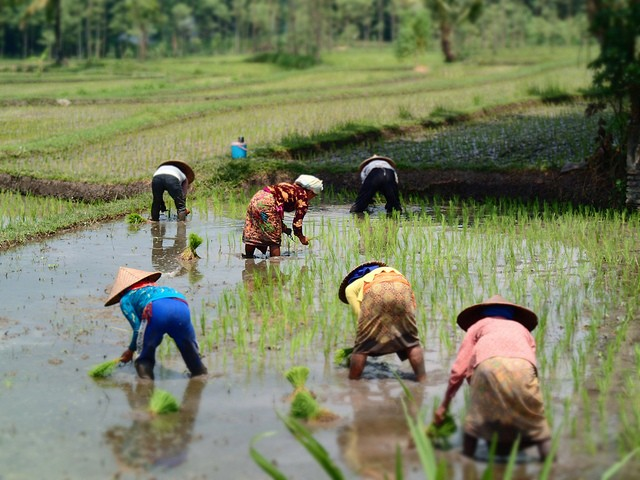
Experts and stakeholders in Egypt warn of imminent water poverty as a result of the Ethiopian Renaissance Dam, which is about to become operational. Meanwhile, agricultural production consumes about 85 per cent of the country’s water resources, half of which goes towards rice irrigation.
Rice cultivation consumes more than 10 billion cubic meters of water annually, or more than one-sixth of Egypt’s share of Nile water, Khaled Ghanem, professor of Organic Farming in Al-Azhar University, told SciDev.Net. And this does not account for the water used for cultivation in unauthorized areas, estimated to be about a third of that used in authorized ones, he explained.
But there could be a solution, in the form of a machine that ploughs fields in a manner that saves about half the amount of water usually used for irrigation, and a quarter of fertilisers used in cultivation. A specially imported unit, which sows rice seedlings mechanically, is mounted on the machine.
The machine’s Egyptian inventor, Mohamed El-Sayyed El-Hagarey, a researcher at the Desert Research Center in Cairo, was granted the prestigious WatSave Award for Young Professionals from the International Commission on Irrigation and Drainage (ICID) during the Second World Irrigation Forum held in Thailand in mid-November.
In an interview with SciDev.Net, El-Hagarey explained his motivation for inventing the machine. He said that during cultivation, rice requires complete submersion in a layer of water 10-15 cm above the soil surface, which demands huge amounts of water and fertilisers.
He designed the soil and water management machine to tackle this. The machine makes ‛V’ shaped lines into the soil, at a depth and width of 20cm, and sows rice seedlings automatically. This operation maintains the water level necessary for rice to grow in the V-shaped troughs, which is less than the water used in conventional agriculture that requires the entire plot of land to be completely submerged.
"This machine will save a lot of irrigation water in Egypt each year, which will help the country face these challenges and direct the water saved towards cultivating other crops." Khaled Ghanem, Al-Azhar University
The machine was tested in a field in Kafr el-Sheikh governorate, which is known for rice crop cultivation in Egypt, with good results. It reduced the amount of water used by half, and “the crop yield increased by 4.6 per cent,” Al-Hagary said.
Atef Sweilem, water management and irrigation expert at the International Center for Agricultural Research in the Dry Areas, (ICARDA), praised the machine, but added that “saving water and fertilisers would not tempt small farmers to buy it, as the increase in the yield was not huge”. He pointed out that the rice agricultural plots owned by most farmers do not exceed half an acre.
“Saving water and fertilisers does not mean much for farmers, who get water for free and fertilisers subsidised by the state,” Sweilem explained.
Therefore, he believes that Egypt’s ministries of Agriculture and Water Resources and Irrigation should play an important role in supporting farmers financially and with training in using the machine.
Al-Hagary said the machine costs about US$5000, but needs further development before it is ready for commercial production.
He intends to re-submit a proposal to the Academy of Scientific Research and Technology in Egypt, hoping it would support further development of the innovation. An earlier proposal made in 2014 went unanswered, and he had to design it at his own expense.
Ghanem believes that “Egypt needs to use this machine widely range for several reasons,” the most important of which is the implications of Ethiopia’s Renaissance Dam on Egypt’s share of water. He also referred to the effects of climate change including drought, desertification, and an increase in evaporation rates, as well as the water wasted along the Nile.
“This machine will save a lot of irrigation water in Egypt each year, which will help the country face these challenges and direct the water saved towards cultivating other crops,” Ghanem said.
He added: “The concerned ministries might not pay attention to this innovation. The solution is to establish major companies to market similar innovations that can be funded by low-priced stocks, making them available to a larger number of consumers.”
